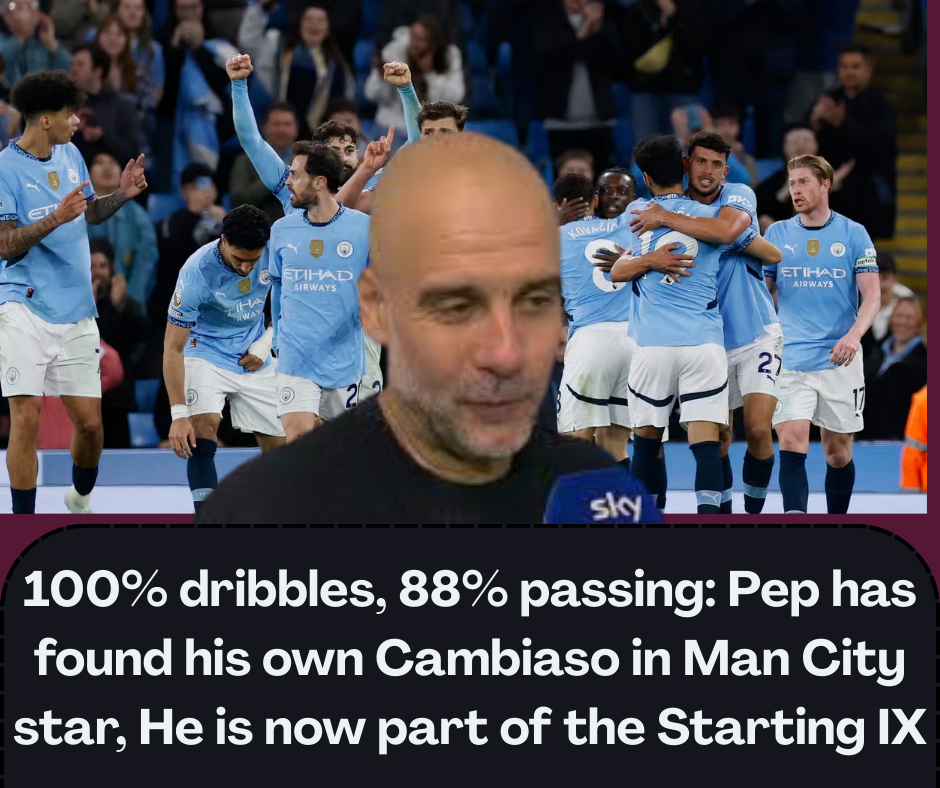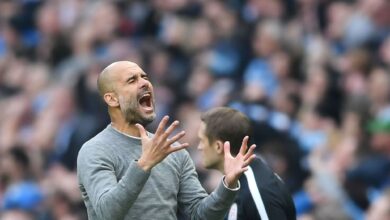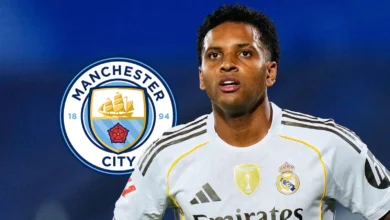Manchester City’s Versatile Solution to Their Full-Back Dilemma

In the ever-evolving landscape of Premier League football, Manchester City’s tactical innovations under Pep Guardiola continue to redefine positional flexibility. As the Citizens secured a crucial 2-1 victory over Aston Villa on Tuesday night, one player in particular has emerged as an unexpected solution to their full-back conundrum: Matheus Nunes. The Portuguese international not only scored the dramatic stoppage-time winner but has steadily established himself as a viable long-term option at right-back, potentially saving the club millions in the upcoming transfer window.
Manchester City’s 2024/25 campaign has been characterized by tactical adaptations and positional experiments, particularly in the defensive line. Following Kyle Walker’s sudden departure in January, the right-back position became a problem area requiring immediate attention. While many expected an emergency signing or a short-term fix, Guardiola instead looked within his squad and identified Nunes – traditionally a central midfielder – as a candidate for the role.
This decision, initially viewed with skepticism by some supporters and pundits alike, has gradually proven inspired. Nunes has started ten of the last fourteen Premier League matches at right-back, displaying remarkable adaptability and growing into the position with each appearance. His performance against Aston Villa – capped by the dramatic winner – demonstrated both his attacking contribution and defensive development.
“He is still learning how to be a right-back,” noted Simon Bajkowski in his player ratings for the Manchester Evening News, acknowledging that Nunes made a “needless error” leading to Villa’s equalizer. However, such mistakes are an expected part of the positional transition and have become increasingly rare as the season has progressed.
As Manchester City contemplate their summer transfer strategy, a key target reportedly on their radar is Juventus defender Andrea Cambiaso. The Italian full-back has impressed in Serie A, with Tuttosport reporting that Juventus values him at approximately €80 million (£68.5 million). However, a detailed statistical comparison between Nunes and Cambiaso reveals striking similarities that might cause City’s recruitment team to reconsider such a substantial investment.
In remarkably similar minutes played this season (2,320 for Nunes versus 2,532 for Cambiaso), both players have displayed comparable metrics across key performance indicators. Nunes has actually outperformed the Italian in several categories, registering more goals (4 vs 2) and assists (9 vs 3) while also showing better aerial duel success (44.8% vs 37.5%) and recording more clearances (29 vs 20) and interceptions (19 vs 16).
Where Cambiaso holds slight advantages – in pass completion percentage (89.3% vs 87.5%) and ground duel success (53.2% vs 45.6%) – the margins are narrow enough to suggest that continued development could see Nunes match or exceed these figures with more experience in the position.
The similarities extend to their stylistic profiles as well. Both players combine technical security in possession with progressive carrying ability, registering 87 and 92 progressive carries respectively. Their touch profiles are
Beyond the raw statistics, Nunes brings several technical and tactical dimensions that make him particularly suited to Guardiola’s interpretation of the right-back role. His background as a midfielder provides him with spatial awareness and passing range that traditional full-backs often lack. This allows him to seamlessly tuck into midfield positions during City’s possession phases, creating numerical advantages in central areas while maintaining structural balance.
Against Aston Villa, Nunes demonstrated his technical quality with an 88% passing accuracy and a perfect 100% dribble success rate. These attributes are especially valuable in Guardiola’s system, where full-backs are expected to contribute significantly to build-up play and possession retention rather than simply providing width.
Loay Mamdouh of Breaking the Lines has highlighted Nunes’ “decision-making” alongside his “technical and physical attributes” as key strengths, qualities that have enabled his successful adaptation to the defensive line. While Graham Ruthven of Forbes noted in January that Nunes “doesn’t have the defensive instincts of a natural full-back,” this assessment came early in his positional transition. The significant minutes he has accumulated in the role since then have visibly improved his defensive positioning and awareness.
Pep Guardiola’s influence on player development cannot be overstated when considering Nunes’ future at right-back. The Catalan coach has a proven track record of reimagining players’ positions, most famously converting Philipp Lahm from full-back to defensive midfielder at Bayern Munich and transforming Javier Mascherano from midfielder to center-back at Barcelona.
At Manchester City, this pattern has continued with notable success. Oleksandr Zinchenko evolved from an attacking midfielder to a left-back, while João Cancelo redefined the “inverted full-back” role before his departure. Most recently, Rico Lewis has demonstrated versatility across the defensive line despite his youth.
Guardiola has publicly expressed his admiration for Nunes, stating that he “is one of the best players in the world today.” Such endorsement carries significant weight given the manager’s exacting standards and suggests that he sees long-term potential in Nunes’ development at right-back.
Manchester City’s potential pivot away from Cambiaso towards entrusting Nunes with the right-back position represents a compelling case study in transfer market efficiency. At a time when elite full-backs command increasingly premium fees – evidenced by the reported £68.5 million valuation of Cambiaso – repurposing an existing squad member offers substantial financial advantages.
The £45 million initially invested in acquiring Nunes from Wolverhampton Wanderers in 2023 was primarily for his midfield capabilities. His successful adaptation to right-back effectively provides Manchester City with two players for the price of one, maximizing return on investment while allowing transfer funds to be allocated to other priority areas.
This approach aligns with the club’s evolving transfer strategy, which has increasingly prioritized versatile players capable of operating effectively across multiple positions. Such flexibility not only provides tactical options but also insulates against injury crises and reduces the need for positional redundancy within the squad.
The immediate context of Nunes’ emergence at right-back cannot be separated from Manchester City’s push for Champions League qualification. Tuesday’s victory over Aston Villa represented a “gigantic step” toward securing a top-four finish, with Nunes’ winner potentially worth millions in guaranteed European revenue for next season.
City’s ascent to third place in the Premier League table provides momentum heading into Sunday’s FA Cup semi-final against Nottingham Forest, where they seek to reach a third consecutive final. Nunes’ versatility offers Guardiola valuable tactical options for this crucial fixture, whether deployed at right-back or returned to midfield depending on the specific matchup requirements.
The timing of Nunes’ development at right-back is particularly fortuitous given Kevin De Bruyne’s impending departure. Although operating in different positions, both players share creative responsibilities within City’s structure, with Nunes’ attacking contributions from defense helping to offset the eventual loss of De Bruyne’s creative output from midfield.
Looking beyond the current season, Nunes’ establishment at right-back opens intriguing tactical possibilities for Manchester City’s future setup. The potential deployment of a player with his technical profile in defense adds another dimension to City’s already formidable possession game, potentially enabling new attacking combinations and build-up patterns.
One particularly promising aspect is the relationship between Nunes and Jérémy Doku, glimpsed in the creation of the winning goal against Aston Villa. Doku’s trivela cross found Nunes arriving at the back post, highlighting the Portuguese player’s intelligent movement and attacking instincts. This connection could be further developed into a potent attacking combination down City’s right flank.
Moreover, Nunes’ comfort in central areas makes him ideally suited to execute the “inverted full-back” role that has become a hallmark of Guardiola’s tactical approach. By moving into midfield positions during possession phases, he can create numerical overloads in central areas while allowing City’s wingers to maintain width and isolate opposing full-backs.
The central question facing Manchester City’s decision-makers ahead of the summer transfer window is clear: pursue the proven but expensive Cambiaso, or continue investing in Nunes’ development at right-back?
The statistical comparison between the two players suggests that the gap in performance is minimal, if it exists at all. Nunes has already demonstrated his capacity to perform at a high level in the position, with his attacking output actually exceeding that of Cambiaso this season.
While Cambiaso offers the advantage of being a natural defender with established positional instincts, Nunes brings a unique technical profile that aligns perfectly with Guardiola’s interpretation of the full-back role. His midfield background provides him with progressive passing abilities and spatial awareness that traditional full-backs often develop only later in their careers.
The £68.5 million reportedly required to secure Cambiaso’s services could be redirected toward other priority positions, particularly as City prepare for life after De Bruyne. With Nunes already demonstrating his capabilities at right-back, the financial argument for internal development rather than external recruitment becomes compelling.
As Manchester City approach the conclusion of another demanding season, the emergence of Matheus Nunes as a legitimate right-back option represents one of the more unexpected yet potentially significant developments of their campaign. His performance against Aston Villa – combining defensive diligence with attacking contribution – offers a glimpse of what could become a long-term positional home.
Guardiola’s track record of positional innovation and player development suggests that Nunes’ transition to right-back is neither accidental nor temporary. Rather, it appears to be part of a deliberate strategy to maximize the Portuguese international’s unique skill set while addressing a positional need within the squad.
The statistical comparison with Cambiaso – a player reportedly commanding a fee in excess of £65 million – reveals that Nunes already performs at a comparable level across most metrics, with superior output in key attacking categories. This raises legitimate questions about the necessity of such significant investment in a position where an internal solution is already demonstrating promise.
As City prepare for a summer of transition, with key figures like De Bruyne departing, the continued development of Nunes at right-back offers both tactical flexibility and financial efficiency. Rather than spending heavily on Cambiaso, Guardiola and the City hierarchy may well decide that their right-back of the future is already within their ranks.
For Nunes personally, the positional transition represents an opportunity to cement his place in one of world football’s elite teams. Having already earned Guardiola’s public praise as “one of the best players in the world today,” his adaptation to right-back could be the key to fulfilling that potential on a consistent basis.
Tuesday night’s match-winning contribution against Aston Villa may well be remembered as more than just a crucial moment in Manchester City’s season – it could mark the emergence of their long-term solution at right-back, saving the club millions in the process.














